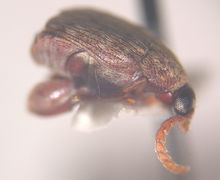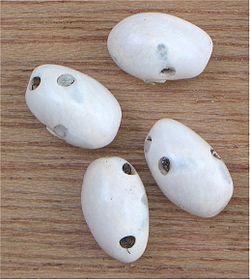| Bean weevils | |
|---|---|
 | |
| Acanthoscelides obtectus | |
| Scientific classification | |
| Kingdom: | Animalia |
| Phylum: | Arthropoda |
| Class: | Insecta |
| Order: | Coleoptera |
| Family: | Chrysomelidae |
| Subfamily: | Bruchinae Latreille, 1802 [1] |
| Genera | |
| About 1,350 species; see text | |
| Diversity | |
| 58 genera | |
The bean weevils or seed beetles are a subfamily (Bruchinae) of beetles, now placed in the family Chrysomelidae, though they have historically been treated as a separate family. They are granivores, and typically infest various kinds of seeds or beans, living most of their lives inside a single seed. The family includes about 4,350 species and are found worldwide.
Bean weevils are generally compact and oval in shape, with small heads somewhat bent under. Sizes range from 1 to 22 mm for some tropical species. Colors are usually black or brown, often with mottled patterns. Although their mandibles may be elongated, they do not have the long snouts characteristic of true weevils.
Adults deposit eggs on seeds, then the larvae chew their way into the seed. When ready to pupate, the larvae typically cut an exit hole, then return to their feeding chamber. Adult weevils have a habit of feigning death and dropping from a plant when disturbed.
Host plants tend to be legumes, but species will also be found in Convolvulaceae, Arecaceae, and Malvaceae, and several species are considered pests.
One characteristic of the beetles which can be seen in the photo is that the elytra are short, not quite reaching the tip of the abdomen.
Several species are native to Great Britain, but there are also records of several introduced species from stored products in warehouses and dwellings, although these species cannot proliferate outside of heated buildings in that climate.
Genera
- This list of genera follows the old systematics, when the family Bruchidae was still valid.[1]
- Rhaebinae Chapuis, 1874
- Rhaebus Fischer von Waldheim, 1824
- Pachymerinae Bridwell, 1929
- Pachymerini Bridwell, 1929
- Pachymerus Thunberg, 1805
- Butiobruchus Prevett, 1966
- Caryobruchus Bridwell, 1929
- Caryoborus Schoenherr, 1833
- †Mesopachymerus Poinar 2005 Canadian amber, Campanian
- Caryedonini Bridwell, 1929
- Mimocaryedon Decelle, 1968
- Caryedon Schoenherr, 1823
- Caryotrypes Decelle, 1968
- Aforedon Decelle, 1965
- Exoctenophorus Decelle, 1968
- Caryopemonini Bridwell, 1929
- Protocaryopemon Borowiec, 1987
- Diedobruchus Pic, 1913
- Caryopemon Jekel, 1855
- Pachymerini Bridwell, 1929
- Amblycerinae Bridwell, 1932
- Amblycerini Bridwell, 1932
- Amblycerus Thunberg, 1815
- Spermophagini Borowiec, 1987
- Zabrotes Horn, 1885
- Spermophagus Schoenherr, 1833
- Amblycerini Bridwell, 1932
- Eubaptinae Bridwell, 1932
- Eubaptus Lacordaire, 1945
- Kytorhininae Bridwell, 1832
- Kytorhinus Fischer von Waldheim, 1809
- Bruchinae Latreille, 1802
- Bruchini Latreille, 1802
- Bruchus Linnaeus, 1767
- Megacerini Bridwell, 1946
- Megacerus Fahraeus, 1839
- Acanthoscelidini Bridwell, 1946
- Gibbobruchus Pic, 1913
- Ctenocolum Kingsolver & Whitehead, 1974
- Caryedes Hummel, 1827
- Meibomeus Bridwell, 1946
- Penthobruchus Kingsolver, 1973
- Pygiopachymerus Pic, 1911
- Merobruchus Bridwell, 1946
- Acanthoscelides Schilsky, 1905
- Mimosestes Bridwell, 1946
- Stylantheus Bridwell, 1946
- Althaeus Bridwell, 1946
- Pseudopachymerina Zacher, 1952
- Neltumius Bridwell, 1946
- Stator Bridwell, 1946
- Sennius Bridwell, 1946
- Megasennius Whitehead & Kingsolver, 1975
- Algarobius Bridwell, 1946
- Scutobruchus Kingsolver, 1968
- Rhipibruchus Bridwell, 1932
- Pectinibruchus Kingsolver, 1967
- Dahlibruchus Bridwell, 1931
- Cosmobruchus Bridwell, 1931
- Lithraeus Bridwell, 1952
- Bonaerius Bridwell, 1952
- Spatulobruchus Borowiec, 1987
- Palpibruchus Borowiec, 1987
- Specularius Bridwell, 1938
- Acanthobruchidius Borowiec, 1980
- Palaeoacanthoscelides Borowiec, 1985
- Horridobruchus Borowiec, 1984
- Callosobruchus Pic, 1902
- Bruchidius Schilsky, 1905
- Salviabruchus Decelle, 1982
- Sulcobruchus Chujo, 1937
- Parasulcobruchus Anton, 1999
- Borowiecus Anton, 1994
- Megabruchidius Borowiec, 1984
- Conicobruchus Decelle, 1951
- Kingsolverius Borowiec, 1987
- Decellebruchus Borowiec, 1987
- Margaritabruchus Romero & Johnson, 2001
- Bruchini Latreille, 1802
- †Myanmaropini Legalov et al, 2020
- †Myanmarops Legalov et al, 2020[2] Burmese amber, Myanmar, Cenomanian
See also
- Caryobruchus gleditsiae
References
- ^ "Bruchinae". Integrated Taxonomic Information System.
- ^ Legalov, Andrei A.; Kirejtshuk, Alexander G.; Anokhin, Boris A. (March 2020). "The oldest seed beetle (Coleoptera; Chrysomelidae: Bruchinae) from Upper Cretaceous amber of northern Myanmar with description of new tribe, genus and species". Cretaceous Research. 107: 104283. doi:10.1016/j.cretres.2019.104283.
- John M. Kingsolver, "Bruchidae", in Ross H. Arnett, Jr. and Michael C. Thomas, American Beetles (CRC Press, 2002), vol. 2 (note that this reference itself indicates the group is a subfamily, and the change was made only after the chapter was written)
